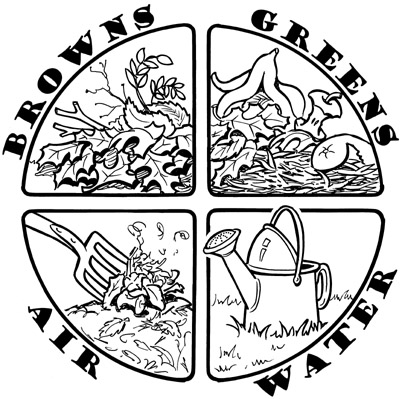How-to Sheet Mulch
This one page brochure covers the basic steps for sheet mulching your lawn. It's an easy process of layering cardboard and mulch right on top of the grass. Plus, you can plant your new garden right into the mulch.
Go From Lawn to Garden
Did you know that you don't need chemicals to kill your water-thirsty lawn? Sheet mulching is an easy process of layering cardboard and mulch right on top of the grass. Plus, you can plant your new garden straight into the mulch. Our Lawn to Garden website has resources that will make your lawn conversion projects easier, including a directory of vendors who provide bulk compost, mulch and other sheet mulch materials.
The Benefits of Sheet Mulching:
Bay-Friendly Basics
Bay-Friendly Basics are nine fundamental steps for creating a healthy garden or landscape that saves water and reduces waste. Many jurisdictions in Alameda County require certain landscape construction projects to meet the Bay-Friendly Basics requirements. Even if local regulations don't require your project to be Bay-Friendly, these practices make good sense for almost all landscape projects.
Plant Debris Landfill Ban Ordinance
ORDINANCE 2008-01
Alameda County Waste Management Authority ordinance prohibiting the disposal of certain materials at Alameda County landfills.
Bay-Friendly Landscaping Guide to Mulch and Mulch Case Study
The Mulch Guide (available in English and Spanish) has detailed information about using mulch to save money, control weeds, and create healthy landscapes. It includes information on types of mulch and how to use them successfully, sample maintenance specifications, information about using mulch for erosion control, photos of mulch installations and more.
The Mulch Case Study showcases the experience of a local landscape professional with chipping and reusing plant debris as mulch.
Troubleshooting Your Worm Bin
Having trouble with your worm bin? Here are tips for some of the most common questions.
FAQ Backyard Composting
Troubleshooting Your Backyard Bin
| Symptoms | Causes | Solutions |
|---|---|---|
| Pile not composting | Too dry | Add water until slightly damp. Turn pile. |
| Too much brown material |
What You Can Compost in Your Backyard Bin
Deciding what to put in your backyard compost bin is an important part of the process. Maintaining the right balance between "brown" and "green" materials will help your compost pile break down faster and keep it from getting smelly. If you are going to compost food scraps you must use a rodent proof bin. For information about what to put in your green bin, check here.
Backyard Composting
 The microorganisms that break down organic material in your soil will happily do the same job in a compost bin. Your role as a composter is to provide the conditions for nature's crew of decomposers—the bacteria, fungi, and bigger creatures such as sow bugs and worms—to go to work. Browns, Greens, Air and Water are the "big four" that will keep every compost pile happy.
The microorganisms that break down organic material in your soil will happily do the same job in a compost bin. Your role as a composter is to provide the conditions for nature's crew of decomposers—the bacteria, fungi, and bigger creatures such as sow bugs and worms—to go to work. Browns, Greens, Air and Water are the "big four" that will keep every compost pile happy.
Related Resources
Learn more about building healthy soil with this guide that provides tips to help you get started in your garden. It covers soil building strategies including composting, sheet mulching and cover cropping.
This in-depth guide can answer all of your compost questions. Whether you are an urban farmer, community gardener, or a backyard homesteader, this toolkit supports you in becoming an expert composter.

El objetivo de este kit de herramientas es proporcionar un enfoque práctico paso a paso para los agricultores urbanos de cualquier escala para comenzar el compostaje en la granja agrícola, evaluar y mejorar el sistema existente, y convertirse en maestros compostadores.